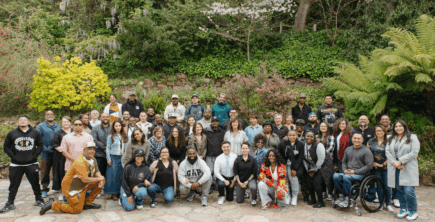
LGBT

The need to support nonprofit workers has never been greater.
Insecurity around grant funding, economic uncertainty, shifts in language, and continued high rates of staff turnover are all contributing to a time of intense strain for the nonprofit sector. Moreover, these effects are not felt equally: while burnout is a risk for all who do social justice work, it’s a risk that looms even larger for women of color, who lead 28% of nonprofits with budgets under $50,000. For these leaders, as Sayu Bhojwani wrote in The Chronicle of Philanthropy, “calls to rest and ‘quiet quit’ fail to acknowledge our reality as women of color. How is it possible to pause when our very existence is at stake?”
Seeing this trend among their own grantees, Susan Byrd and the Women & Girls Leadership Fund moved to fund an additional $5,000 in project support for each 501(c)(3) organization to support staff wellness on their own terms while keeping support steady to their original funding agreement. This was the foundation’s first experience with designating funding for staff wellness, and it provides an important example of how wellness grants for nonprofits can be initiated — and what they make possible.
Each of the Women & Girls Leadership Fund organizations had the opportunity to spend those funds on staff wellness in whichever way was most helpful; grant letters left the language open for interpretation of an organization’s specific needs. Three common themes quickly emerged:
Support for in-person collaboration was especially critical for teams that operate remotely with staff spanning the U.S. and abroad. The 19th News, an independent nonprofit newsroom reporting on gender, politics, and policy, used their stipend to cover wellness related activities at a team retreat and networking event in New Orleans, LA that included engagement with local journalists and fellows.
Individual wellness stipends were selected by staff to cover wellness expenses like gym, spa, or other health focused programs that they might otherwise not be able to cover. She’s the First, a 501(c)(3) focused on global girls’ empowerment, hosted a discussion among staff about what wellness meant to them. The leadership team then decided to give staff autonomy on an individual use of the stipend that was divided with equity in mind.
It’s difficult sometimes to be intensely focused on a girl’s story about her experience with FGM, poverty, or sexual assault and then be expected to quickly switch back to… your own life or even regular day-to-day work responsibilities. This work can consume you. So, when I heard that a funder recognized that difficulty, I felt seen and respected. I felt like a funder understood that real people are behind our work and that we need outlets to care for our mental health.
— Staff Member, She’s the First
Communal team meals or activities were important for organizations with staff who wanted more flexibility in community building. CAMFED, a leader in girls’ education and leadership initiatives in Africa, launched a new book club with facilitation from the celebrated authors of Everyday Ubuntu, to deepen their understanding of Ubuntu and help integrate Ubuntu principles into our workplace. A staff member called the sessions “inspiring, invigorating, and stimulating.”
View this post on Instagram
These supplemental wellness grants had an impact that was far disproportionate to the amount that was awarded. Many leaders relayed the power of hosting conversations around staff wellness in leadership circles and in staff meetings. Directors learned more genuinely what wellness and care meant to their team. These grants gave space and flexibility for staff to engage in personal and meaningful relationship building, which is often discussed or encouraged in nonprofit and funder spaces yet rarely supported with funds. One program manager shared that “[I]n my 10 years in the nonprofit world I’ve heard so many times that funders don’t even want to allocate funds to my salary, let alone extra to benefit my health. In an industry where burnout is so rampant, it felt really special to have this moment of unexpected generosity and care.”
Funders looking to support staff wellness through their grantmaking may wonder whether designating certain funds for staff wellness violates the principles of trust-based philanthropy. While Tides Foundation lists general support grants as the best practice in grantmaking, these staff wellness grants demonstrated how strategic restricted funding can also be deployed to lift staff up directly. Restricted funding like this can ensure that those working closely with difficult, traumatic social issues that funders care deeply about have access to teamwide supplemental enrichment.
Generous multiyear general support grants are powerful tools that let nonprofits deliver on their missions. However, if funding is tight, staff travel or supplemental supports are often the first items to be cut. In fact, most of the Women & Girls Leadership Fund grantee partners noted that they hadn’t considered requesting funding for staff wellness given how difficult the nonprofit fundraising ecosystem could be. By allocating supplemental funding for staff wellness — and leaving the interpretation of that allocation open-ended — funders can create meaningful systems of support and care while acknowledging that those systems will look different for different individuals, teams, and organizations.
Tides is working with doers and donors to strengthen nonprofit resilience and shift power to communities which have been historically denied it. Sign up for news from Tides and never miss an update.

LGBT

Corporate Partners

Philanthropy

Read the stories and hear the voices of social change leaders fighting for justice.